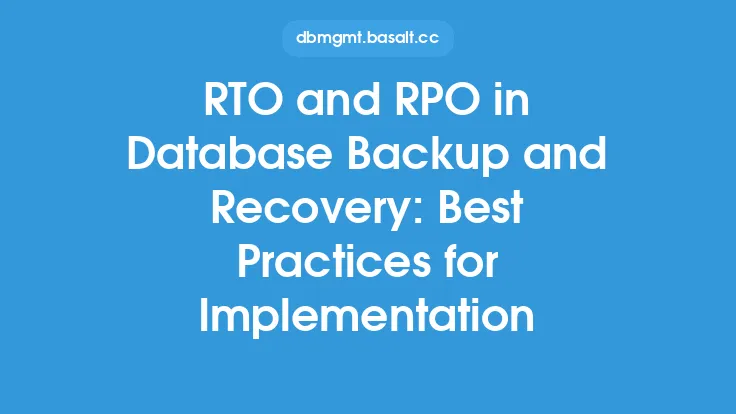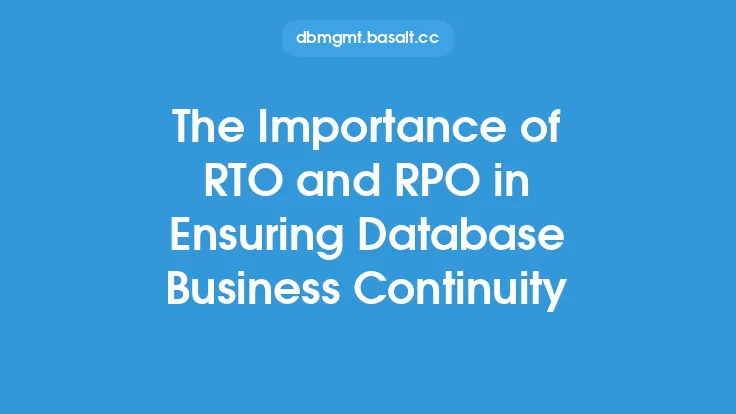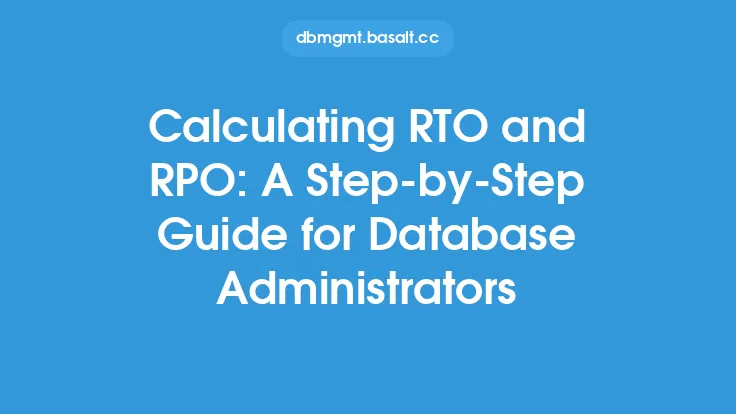When it comes to database backup and recovery strategies, two crucial metrics play a significant role in determining the effectiveness of these strategies: Recovery Time Objective (RTO) and Recovery Point Objective (RPO). These metrics are essential in ensuring that databases are properly backed up and can be recovered in a timely manner, minimizing data loss and downtime. In this article, we will delve into the impact of RTO and RPO on database backup and recovery strategies, exploring how they influence the design and implementation of these strategies.
Introduction to RTO and RPO
RTO and RPO are two related but distinct metrics that are used to measure the effectiveness of database backup and recovery strategies. RTO refers to the maximum amount of time that an organization can tolerate being without access to its database, while RPO refers to the maximum amount of data that can be lost in the event of a disaster or outage. In other words, RTO is about how quickly the database needs to be restored, while RPO is about how much data can be lost before it becomes unacceptable.
Impact of RTO on Database Backup and Recovery Strategies
The RTO has a significant impact on database backup and recovery strategies. A low RTO requires that the database be restored quickly, which means that the backup and recovery process must be optimized for speed. This can involve using faster backup and recovery technologies, such as disk-based backups or snapshot-based backups, as well as implementing automated backup and recovery processes to minimize manual intervention. Additionally, a low RTO may require that multiple backup copies be maintained, both on-site and off-site, to ensure that the database can be restored quickly in the event of a disaster.
Impact of RPO on Database Backup and Recovery Strategies
The RPO also has a significant impact on database backup and recovery strategies. A low RPO requires that data be backed up frequently, to minimize the amount of data that can be lost in the event of a disaster or outage. This can involve using more frequent backup schedules, such as hourly or daily backups, as well as implementing real-time data replication or continuous data protection (CDP) technologies. Additionally, a low RPO may require that backup data be stored for longer periods of time, to ensure that data can be recovered in the event of a disaster or outage.
Balancing RTO and RPO
Balancing RTO and RPO is critical in database backup and recovery strategies. A low RTO may require more frequent backups, which can increase the storage requirements and costs associated with backup and recovery. On the other hand, a low RPO may require more frequent backups, which can increase the overhead and impact on database performance. Therefore, it is essential to balance RTO and RPO to ensure that the database backup and recovery strategy meets the organization's requirements for data availability and protection.
Technical Considerations
From a technical perspective, RTO and RPO have a significant impact on the design and implementation of database backup and recovery strategies. For example, the choice of backup technology, such as tape-based or disk-based backups, can impact RTO and RPO. Tape-based backups may be more suitable for long-term data retention, but may not provide the fast recovery times required for low RTOs. On the other hand, disk-based backups may provide faster recovery times, but may be more expensive and require more storage capacity.
Backup and Recovery Technologies
Various backup and recovery technologies are available to support RTO and RPO requirements. These include:
- Snapshot-based backups: These involve creating a snapshot of the database at a point in time, which can be used to restore the database quickly in the event of a disaster or outage.
- Disk-based backups: These involve backing up data to disk, which can provide faster recovery times than tape-based backups.
- Real-time data replication: This involves replicating data in real-time, which can provide a low RPO and ensure that data is always available.
- Continuous data protection (CDP): This involves continuously backing up data, which can provide a low RPO and ensure that data is always available.
Conclusion
In conclusion, RTO and RPO have a significant impact on database backup and recovery strategies. A low RTO requires that the database be restored quickly, while a low RPO requires that data be backed up frequently to minimize data loss. Balancing RTO and RPO is critical to ensure that the database backup and recovery strategy meets the organization's requirements for data availability and protection. By understanding the technical considerations and backup and recovery technologies available, organizations can design and implement effective database backup and recovery strategies that meet their RTO and RPO requirements.





